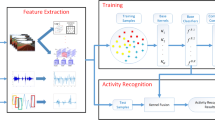Abstract
Kernel-based methods have gained great attention by researchers in the field of pattern recognition and statistical machine learning. They are the most nominated algorithms whenever a non-linear classification model is required. Human activity recognition has also been highlighted by researchers in the area of computer vision. This focusing has been triggered by the interest in many applications, such as, activity recognition in surveillance systems, robotics, wireless interfaces and interactive environments. It has been observed that the literature lacks the use of the kernel technique in the context of human activity recognition. In this context, this paper introduces a non-linear eigenvector-based recognition model that is built upon the idea of the kernel technique. The paper gives a practical study of using the kernel technique showing how much crucial choosing the right kernel function is, for the success of the linear discrimination in the feature space. The rich implementation results provided in this paper were obtained by applying the model on two of the most common used benchmark datasets in the field of human activity recognition, KTH and Weizmann.
Access this chapter
Tax calculation will be finalised at checkout
Purchases are for personal use only
Preview
Unable to display preview. Download preview PDF.
Similar content being viewed by others
References
Diaf, A., Ksantini, R., Boufama, B., Benlamri, R.: A Novel Human Motion Recognition Method Based on Eigenspace. In: Campilho, A., Kamel, M. (eds.) ICIAR 2010, Part I. LNCS, vol. 6111, pp. 167–175. Springer, Heidelberg (2010)
Meng, H., Freeman, M., Pears, N., Bailey, C.: Real-time human action recognition on an embedded, reconfigurable video processing architecture. Journal of Real-Time Image Processing 3(3), 163–176 (2008)
Moeslund, T., Hilton, A., Kruger, V.: A survey of advances in vision-based human motion capture and analysis. Computer Vision and Image Understanding 104(2), 90–126 (2006)
Dornaika, F., Davoine, F.: On appearance based face and facial action tracking. IEEE Transactions on Circuits and Systems for Video Technology 16(9), 1107–1124 (2006)
Diaf, A., Benlamri, R., Boufama, B.: An effective view-based motion representation for human motion recognition. In: International Symposium on Modeling and Implementing Complex Systems, pp. 57–64 (2010)
Bobick, A., Davis, J.: The recognition of human movement using temporal templates. IEEE Transactions on Pattern Analysis and Machine Intelligence 23(3), 257–267 (2001)
Rahman, M., Ishikawa, S.: Human motion recognition using an eigenspace. Pattern Recognition Letters 26, 687–697 (2005)
Ogata, T., Tan, J., Ishikawa, S.: High-speed human motion recognition based on a motion history image and an eigenspace. IEICE - Transactions on Information and Systems E89-D(1), 281–289 (2006)
Shawe-Taylor, J., Cristianini, N.: Kernel methods for pattern analysis. Cambridge University Press (2004)
Melgani, F., Bruzzone, L.: Classification of hyperspectral remote sensing images with support vector machines. IEEE Transactions on Geosci. Remote Sens. 42(8), 1778–1790 (2004)
Valls, G., Bruzzone, L.: Kernel-based methods for hyperspectral image classification. IEEE Transactions on Geosci. Remote Sens. 43(6), 1351–1362 (2005)
Aizerman, A., Braverman, E.M., Rozoner, L.I.: Theoretical foundations of the potential function method in pattern recognition learning. Automation and Remote Control 25, 821–837 (1964)
Schölkopf, B., Smola, A., Müller, K.: Nonlinear component analysis as a kernel eigenvalue problem. Neural Comput. 10, 1299–1319 (1998)
Mika, S., Rätsch, G., Weston, J., Schölkopf, B., Müller, K.: Fisher Discriminant Analysis with Kernels, vol. IX, pp. 41–48. IEEE (1999)
Hilbert, D.: Grundzüge einer allgemeinen Theorie der linearen Integralgleichungen. Teubner (1912)
Boser, B., Guyon, I., Vapnik, V.: A training algorithm for optimal margin classifiers. In: Proceedings of the 5th Annual ACM Workshop on Computational Learning Theory, pp. 144–152. ACM Press (1992)
Mercer, J.: Functions of positive and negative type and their connection with the theory of integral equations. Philos. Trans. Royal Soc. (A) 83(559), 69–70 (1909)
Schuldt, C., Laptev, I., Caputo, B.: Recognizing human actions: A local svm approach. In: Proceedings of the 17th International Conference on Pattern Recognition, vol. 3, pp. 32–36 (August 2004)
Gorelick, L., Blank, M., Shechtman, E., Irani, M., Basri, R.: Actions as space-time shapes. Transactions on Pattern Analysis and Machine Intelligence 29(12), 2247–2253 (2007)
Author information
Authors and Affiliations
Editor information
Editors and Affiliations
Rights and permissions
Copyright information
© 2012 Springer-Verlag Berlin Heidelberg
About this paper
Cite this paper
Diaf, A., Benlamri, R., Boufama, B. (2012). Nonlinear-Based Human Activity Recognition Using the Kernel Technique. In: Benlamri, R. (eds) Networked Digital Technologies. NDT 2012. Communications in Computer and Information Science, vol 294. Springer, Berlin, Heidelberg. https://doi.org/10.1007/978-3-642-30567-2_29
Download citation
DOI: https://doi.org/10.1007/978-3-642-30567-2_29
Publisher Name: Springer, Berlin, Heidelberg
Print ISBN: 978-3-642-30566-5
Online ISBN: 978-3-642-30567-2
eBook Packages: Computer ScienceComputer Science (R0)




